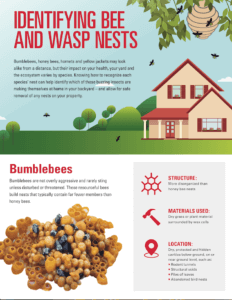While bees and wasps have many physical similarities, their impact on your health, yard and ecosystem varies by species. The nests of these pests can help identify which of these flying fiends are buzzing around your home and allow for proper removal of nests in your yard.
Painful Stings
Bees and wasps can leave painful stings on unexpecting victims. These stings can not only leave you and your family itching for hours but can cause severe allergic reactions in sensitive individuals. Stings can cause welts or an elevated skin surface around the sting site and leave a central white spot where the stinger punctured the skin. Toxic reactions may also occur when there are multiple stings and there is an excessive amount of venom in the body.
While some species are more aggressive than others, it is important to leave any nests undisturbed and contact a professional to determine removal strategies. Disturbing a nest can cause colony members to attack in defense of their colony.
Bee Gone, Bees and Wasps
Pollinators like honey bees are protected, as they are crucial for the ecosystem. Having a professional safely remove bee and wasp nests is essential to protect these pests and leave your property pest free. To prevent bees and wasps from making their next nest in your yard:
- Clean up all spills around your property immediately
- Cover outdoor trash cans with a tight-fitting lid
- Plant flowers and fruit trees away from heavily trafficked areas
- Paint, stain and weather-treat wooden structures like railings
- Remove debris from the yard
Don’t let bees and wasps be the buzz around your home. Download this guide on identifying bee and wasp nests or talk to your pest management provider for an inspection and proper nest removal.
Video:
Remove pests from your home, and stop them from coming back
We work hard to listen, understand and assess your unique situation. Request a free, no-obligation estimate today for a customized pest program that fits your needs.
Request a Free Home EstimateRequest a Free Business Consultation
You may also like
Avoid Painful Pests This Canada Day
Barbeques, fireworks, parades and…bug bites? While each of these activities are perfect for summer celebrations like Canada Day, summertime is also the ideal season for biting and stinging pests to come out in full force. Identifying which of these pests might make an appearance in your backyard can help you take the steps necessary to protect your home – and potential party guests – from their painful bites.
What the Buzz is All About: A Breakdown of Common Bees
It’s easy to think of bees as aggressive or harmful, but the truth is, they’re quite beneficial. Bees are pollinators, which means they help plant populations bloom and thrive. So, while they may annoy you at a backyard cookout—or potentially cause an allergic reaction when they sting—bees are also essential stewards of the environment.
Remove pests from your home, and stop them from coming back
We work hard to listen, understand and assess your unique situation. Request a free, no-obligation estimate today for a customized pest program that fits your needs.
Request a Free Home EstimateRequest a Free Business Consultation


